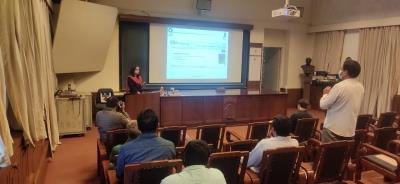
B'luru institute takes big leap in quantum communication
(MENAFN- IANS) p>Bengaluru, Feb 22 (IANS) Researchers team headed by Urbasi Sinha at the Raman Research Institute (RRI) successfully demonstrated free space quantum distribution key between two buildings in the institute using an atmospheric channel.
This is the first time the technique - called entanglement-based quantum-key distribution - has been demonstrated using ground stations based in RRI at a distance of 50 meters apart.
This breakthrough experiment - new and improved protocol for quantum communication - is poised to revolutionise security for strategic sectors like - banking, defence, cyber security - as well as for the applications involving the common man.
Soon after the sun was set on Sunday, she demonstrated this new protocol, invisible to anyone but to two special telescopes that are set up in RRI premises at around 50 meters apart.
"This is the country's first free space quantum key distribution experiment. This experiment can be done and demonstrated only during the night," Sinha told reporters who heads the Quantum Information and Computing (QuIC) laboratory at the RRI as well as India's first project on satellite based secure quantum communications.
This project is a joint collaboration between the RRI and India Space Research Organisation (ISRO) and both came up together in 2017 to set up a laboratory called - Quantum Experiments Using Satellite Technology (QuEST) and Sinha heads this lab.
She described that this is a breakthrough milestone in the country as this will pave the way for longer distances using atmospheric channels, which ultimately culminating with ground to satellite based secure quantum communications.
According to her, the widely used information transfer protocols employ a secret "key" known only to the communicating parties, who can encrypt and decrypt the messages.
She explained that the entanglement based Quantum Key Distribution or QKD has an additional advantage in paving the way towards device independent QKD, where security is not compromised by vulnerability devices.
Sinha further added that this atmospheric channel based experiment is a big leap in terms of the union government's vision of connecting different nodes in the country through free space and fibre based channels towards building a secure quantum based communication network.
She added that each secret key is one of two strings of entangled photon pairs. "A unique property of this is that any unauthorized break-in is immediately detected. It also protects the encrypted information from threats that might arise from future advances in computational power," she said.
Elated Sinha added that quantum computers will also be capable of running certain algorithms that will in turn make existing computers (Classical computers) crypto-systems more vulnerable to hacking or corruption. "Classical computers are based on mathematical problems and quantum computers are based on laws of Quantum physics. Therefore, Classical computers will be vulnerable to cyber attacks whereas quantum computers are future secure," she explained.
--IANS
nbh/rt

Legal Disclaimer:
MENAFN provides the
information “as is” without warranty of any kind. We do not accept
any responsibility or liability for the accuracy, content, images,
videos, licenses, completeness, legality, or reliability of the information
contained in this article. If you have any complaints or copyright
issues related to this article, kindly contact the provider above.
Most popular stories
Market Research

- Bitmex Launches Uptober Carnival Featuring A $1,000,000 Prize Pool
- SPAYZ.Io White Paper Explores Opportunities, Challenges And Ambitions In Payments Industry
- Pendle Grows An Additional $318 Million TVL Just 4 Days After Plasma Launch
- Rome Launches Its Genesis NFT Collection“Imperia” On Magic Eden Launchpad
- Xone Chain Announces Ecosystem Evolution Following Sunflower Letter
- Casper (CSPR) Is Listed On Gate As Part Of Continued U.S. Market Expansion




















Comments
No comment